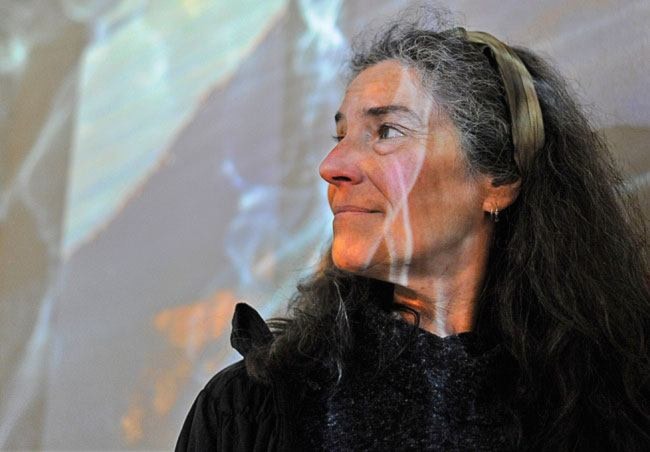Whitehorse artist Joyce Majiski spent 14 years as a wilderness guide, so she’s skilled at helping people know where they are and where they are headed. But as her current exhibition North of Myth reveals, on a personal level she remains fascinated with finding the edges of individual and geographic knowledge.
Majiski is one of the Yukon’s most established artists, known especially for her printmaking and her nuanced depictions of wildlife. Whales, caribou, bison, wolves and, surprisingly, jellyfish, accompany lichen, ocean and stone formations in this current multimedia and mixed-media exhibition at the Yukon Arts Centre. Sculpture, artist books and a glacier-inspired installation round out the space.
In her 30 years of Yukon living, Majiski has frequently explored themes of northernness. Her work has become increasingly collaborative as she asks herself and others what “northernness” means to them.
This Thursday, the community-minded artist has invited four Yukon poets to read their northern-inspired writing, surrounded by the North of Myth artwork.
Host Ellen Bielawski is a non-fiction writer with a doctorate in Arctic archeology who has worked across Nunavut, the Northwest Territories, Alaska and the Yukon. Her perspective on North will provide intriguing introductions for readings by Erling Friis-Baastad, Joanna Lilley, Michael Eden Reynolds and Clea Roberts.
Many works in the exhibition are inspired by Majiski’s experiences in 2013 on the Arctic Circle Residency. The two-week residency on a tall ship out of Norway took Majiski and 26 other artists (including Whitehorse painter Jane Isakson) from Svalbard to within 966 kilometres of the North Pole.
The ship made daily shoreline stops for exploration. In the evenings, guides gave talks about the history, flora and fauna of the area. Majiski was struck by how explorers in the Svalbard area were eager to go beyond known coordinates, even though it was a location without an indigenous or other continuous population.
When the group visited the remains of a centuries-old explorers’ building, Majiski notes, she thought: “That sense of not knowing where you were - not knowing if you were going to fall off the edge of the earth - that wasn’t that long ago. To truly, truly not know where you were in the world would have been a really interesting thing.”
After the high seas, Majiski expanded her longstanding love of old maps with a residency in Can Serrat, Spain. The space was smaller than she’d expected, so she was not able to start printmaking. Instead, she began putting ideas together on the computer and drawing out many variations of compass roses.
Then a link between Norway and Spain surfaced and inspired the printmaker to plunge into poetry more than ever before. The Svalbard archipelago contains Magdalena Fjord, laced with historical sites from Norway’s whaling, and the Arctic Circle Residents visited some of these. In Spain, Majiski visited an aquarium with displays about whaling history and ideas started to come together.
“The whaling places are a lot of rock and ice, not a lot of vegetation, but in one space there was all this moss that was a vibrant green,” she says. In her journals she noted learning that, over the years, oil spilled by whalers created the micro ecosystem that fed the moss. “The first whalers in that area had been Basque, and there I was in Basque country looking at these artifacts from whaling history, and everything just began to connect.”
“I’ve been writing poetry on the sly for years,” she confesses with a grin. The words started to pour, and eventually Majiski transformed them into eight artist books, with editing help from Lilley. The colour of the whale-oil-fed moss appears in the print “Magdalena Fjord” and those whale images resurface in “If the Whale Had Teeth,” one of the more whimsical pieces in the exhibit.
“Inside the Glacier” is worth an extended visit. In this installation, blues and silvery reflections shimmer between long strips of mylar and paper. They hang loosely from the ceiling so that even the subtle air currents caused by walking by will make the strips sway. The brightness comes from Arctic images streaming from two projectors, and a mesmerizing soundscape by Irish composer Karen Power tugs at viewers to stay and absorb the slow shifts. Power was another artist on the Arctic Circle Residency, and Majiski’s careful listening to the composer’s work led to the creation of a unique piece.
The second show at the Yukon Arts Centre also speaks to collaboration and mutual support. Alchemy of Collaboration by California artist Zea Morvitz showcases both Morvitz’s vivid ink drawings and two major collaborative projects with Majiski. The first piece in the gallery is “Canyon Flow,” a pair of scroll-length drawings the two artists drew together after spending time at Miles Canyon.
Then comes a whole wall’s worth of handmade postcards created by the artists each Friday over the period of one year. Viewers are welcome to handle them gently if they want to read the extended conversation.
Conversation and an immersion in visual stories are gifts offered in the North of Myth show until Feb. 21. The Jan. 29 poetry reading starts at 7:30 p.m., with doors open at 7 p.m. so visitors can view the show first.
Meg Walker is a visual artist and writer based in Dawson City.
